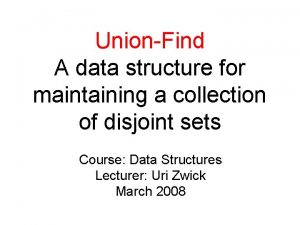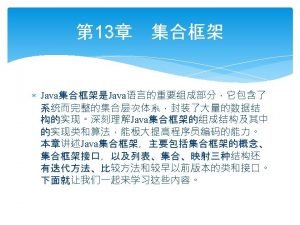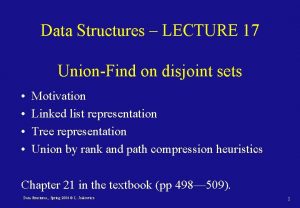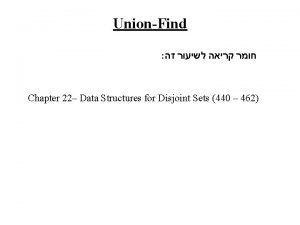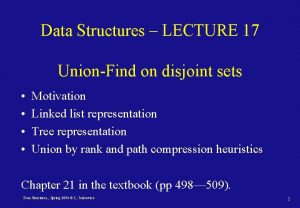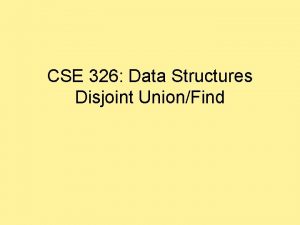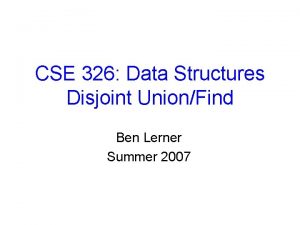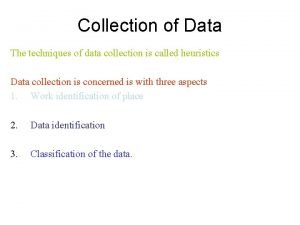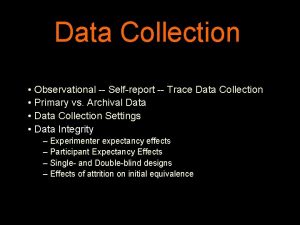UnionFind A data structure for maintaining a collection


























![n log*(n) [0, 2] [3, 4] [ 5 , 16 ] [ 17 n log*(n) [0, 2] [3, 4] [ 5 , 16 ] [ 17](https://slidetodoc.com/presentation_image_h/1e02eb11d208a801232c6ddeb44eaade/image-27.jpg)


![[ 0 , 2 ] [ 3 , 4 ] [ 5 , [ 0 , 2 ] [ 3 , 4 ] [ 5 ,](https://slidetodoc.com/presentation_image_h/1e02eb11d208a801232c6ddeb44eaade/image-30.jpg)
![[ 0 , 2 ] The number of nodes of level 1 [ 0 , 2 ] The number of nodes of level 1](https://slidetodoc.com/presentation_image_h/1e02eb11d208a801232c6ddeb44eaade/image-31.jpg)


















![Amortized cost of find y=p’[x] rank[x] is unchanged rank[p[x]] is increased level(x) is either Amortized cost of find y=p’[x] rank[x] is unchanged rank[p[x]] is increased level(x) is either](https://slidetodoc.com/presentation_image_h/1e02eb11d208a801232c6ddeb44eaade/image-50.jpg)


- Slides: 52

Union-Find A data structure for maintaining a collection of disjoint sets Course: Data Structures Lecturers: Haim Kaplan and Uri Zwick Last Updated: June 11, 2018

Union-Find •

Union Find a b c a Make-Set() b Make-Set() Union(a, b) Find(b) a Find(a) a d e c Make-Set() d Make-Set() e Make-Set() Union(c, d) Union(d, e) Find(e) d

Union-Find Make-Set Link Find Amortized Worst Amortized Case. Inverse Ackermann “almost constant”

Important aplication: Incremental Connectivity A graph on n vertices is built by adding edges At each stage we may want to know whether two given vertices are already connected 5 2 7 4 1 3 Union(1, 2) Union(2, 7) 6 Find(1)=Find(6)? Union(3, 5) …

Fun aplication: Generating mazes 1 2 3 4 c 16 Make-Set(16) 5 6 7 8 find(c 6)=find(c 7) ? union(c 6, c 7) 9 10 11 12 find(c 7)=find(c 11) ? union(c 7, c 11) 13 14 15 16 … c 1 Make-Set(1) c 2 Make-Set(2) … Choose edges in random order and remove them if they connect two different regions

Fun aplication: Generating mazes 1 2 3 4 5 6 7 8 9 10 11 12 13 14 15 16

Generating mazes – a larger example

More serious aplications: • • Maintaining an equivalence relation Incremental connectivity in graphs Computing minimum spanning trees …

Implementation using linked lists Each set is represented as a linked list Each item has a pointer to the list List = Set first last size α χ a x k … β γ

Union using linked lists first last size k 1 k 2 α δ β γ y x ε η Concatenate the two lists Change “list pointers” of shorter list … ξ

Union Find using linked lists Analysis But… Whenever the list pointer of an item is changed, the size of the list containing it has at least doubled.

Union-Find using linked lists Make-Set Union Find Amortized

Union-Find using linked lists Make-Set Union Find Amortized

Union-Find Make-Set Link Find Amortized Worst Amortized Case. Inverse Ackermann “almost constant”

Union Find using Trees Represent each set as a rooted tree Union by rank Path compression

Union by rank 0

Union by rank 0 Proofs: By easy induction.

Union by rank 0 Corollaries:

Path Compression After climbing to the root, make all the nodes visited point directly to the root! This increases the cost of Find by at most a constant factor, but may significantly speed-up subsequent Find operations.

Union Find - pseudocode

Union-Find Union by rank + Path compression Worst case Make-set Link Find Amortized Make-set Link Find

Nesting / Repeated application

Ackermann’s function (one of many variations)

The Tower function n T(n) 1 2 2 4 3 16 4 65, 536 5 265, 536

Inverse functions
![n logn 0 2 3 4 5 16 17 n log*(n) [0, 2] [3, 4] [ 5 , 16 ] [ 17](https://slidetodoc.com/presentation_image_h/1e02eb11d208a801232c6ddeb44eaade/image-27.jpg)
n log*(n) [0, 2] [3, 4] [ 5 , 16 ] [ 17 , 65, 536 ] [ 65, 537 , 265, 536 ] 1 2 3 4 5

Inverse Ackermann function is the inverse of the function

We use a variant of the accounting method in which items accumulate debits
![0 2 3 4 5 [ 0 , 2 ] [ 3 , 4 ] [ 5 ,](https://slidetodoc.com/presentation_image_h/1e02eb11d208a801232c6ddeb44eaade/image-30.jpg)
[ 0 , 2 ] [ 3 , 4 ] [ 5 , 16 ] [ 17 , 65, 536 ] [ 65, 537 , 265, 536 ] 1 2 3 4 5
![0 2 The number of nodes of level 1 [ 0 , 2 ] The number of nodes of level 1](https://slidetodoc.com/presentation_image_h/1e02eb11d208a801232c6ddeb44eaade/image-31.jpg)
[ 0 , 2 ] The number of nodes of level 1

The ranks along each path are increasing. Partition the nodes along a search path into levels. = last node in a level (or a child of the root) root

Otherwise, we charge the Find operation. What is the total charge to all the nodes in an arbitrary sequence of operations ? ? ?

A node is only charged when it is no longer a root.

Charge to each Find amort(Make-Set) Total charge to all nodes over all Find’s amort(Find)

Make-Set Link Find Amortized What we proved What we promised

Total charge to nodes

Lowest Common Ancestor (LCA) LCAT(x, y) – The lowest node z which is an ancestor of both x and y a T e c b f g d h LCA(e, k) = a LCA(f, g) = b LCA(c, h) = c … i j k

The off-line LCA problem Given a tree T and a collection P of pairs, find LCAT(x, y) for every (x, y) P Using Union-Find we can get O((m+n)) time, where n=|T| and m=|P| There are more involved linear time algorithms, even for the on-line version

The off-line LCA problem Going down: u v Make-Set(v) We want these to be the representatives (How do we do it? ) If w<v, then LCA(w, v) = “Find(w)” u Going up: v u Union(u, v) v

The O( (n)) upper bound for Union-Find (For those interested)

Amortized analysis (reminder) Actual cost of i-th operation Amortized cost of i-th operation Potential after i-th operation

Amortized analysis (cont. ) Total actual cost

Level and Index Back to union-find…

Potentials

Definition Claim Bounds on level Proof

Bounds on index

Amortized cost of make Actual cost: O(1) : 0 Amortized cost: O(1)

Amortized cost of link x y Actual cost: O(1) z 1 … zk The potentials of y and z 1, …, zk can only decrease The potentials of x is increased by at most (n) Amortized cost: O( (n))
![Amortized cost of find ypx rankx is unchanged rankpx is increased levelx is either Amortized cost of find y=p’[x] rank[x] is unchanged rank[p[x]] is increased level(x) is either](https://slidetodoc.com/presentation_image_h/1e02eb11d208a801232c6ddeb44eaade/image-50.jpg)
Amortized cost of find y=p’[x] rank[x] is unchanged rank[p[x]] is increased level(x) is either unchanged or is increased p[x] x If level(x) is unchanged, then index(x) is either unchanged or is increased If level(x) is increased, then index(x) is decreased by at most rank[x]– 1 is either unchanged or is decreased

Amortized cost of find xl Suppose that: xj xi x=x 0 (x) is decreased !

Amortized cost of find xj x=x 0 xi xl The only nodes that can retain their potential are: the first, the last and the last node of each level Actual cost: l +1 ( (n)+1) – (l +1) Amortized cost: (n)+1
 Static and dynamic queue in data structure
Static and dynamic queue in data structure Landsat collection 1 vs collection 2
Landsat collection 1 vs collection 2 Types of documentary collection
Types of documentary collection Define data collection method
Define data collection method The terms external secondary data and syndicated
The terms external secondary data and syndicated Formuö
Formuö Typiska drag för en novell
Typiska drag för en novell Tack för att ni lyssnade bild
Tack för att ni lyssnade bild Vad står k.r.å.k.a.n för
Vad står k.r.å.k.a.n för Varför kallas perioden 1918-1939 för mellankrigstiden
Varför kallas perioden 1918-1939 för mellankrigstiden En lathund för arbete med kontinuitetshantering
En lathund för arbete med kontinuitetshantering Adressändring ideell förening
Adressändring ideell förening Tidböcker
Tidböcker Anatomi organ reproduksi
Anatomi organ reproduksi Förklara densitet för barn
Förklara densitet för barn Datorkunskap för nybörjare
Datorkunskap för nybörjare Tack för att ni lyssnade bild
Tack för att ni lyssnade bild Debatt artikel mall
Debatt artikel mall Delegerande ledarstil
Delegerande ledarstil Nyckelkompetenser för livslångt lärande
Nyckelkompetenser för livslångt lärande Påbyggnader för flakfordon
Påbyggnader för flakfordon Arkimedes princip formel
Arkimedes princip formel Svenskt ramverk för digital samverkan
Svenskt ramverk för digital samverkan Urban torhamn
Urban torhamn Presentera för publik crossboss
Presentera för publik crossboss Argument för teckenspråk som minoritetsspråk
Argument för teckenspråk som minoritetsspråk Kanaans land
Kanaans land Treserva lathund
Treserva lathund Mjälthilus
Mjälthilus Claes martinsson
Claes martinsson Cks
Cks Verifikationsplan
Verifikationsplan Mat för unga idrottare
Mat för unga idrottare Verktyg för automatisering av utbetalningar
Verktyg för automatisering av utbetalningar Rutin för avvikelsehantering
Rutin för avvikelsehantering Smärtskolan kunskap för livet
Smärtskolan kunskap för livet Ministerstyre för och nackdelar
Ministerstyre för och nackdelar Tack för att ni har lyssnat
Tack för att ni har lyssnat Hur ser ett referat ut
Hur ser ett referat ut Redogör för vad psykologi är
Redogör för vad psykologi är Borstål, egenskaper
Borstål, egenskaper Atmosfr
Atmosfr Borra hål för knoppar
Borra hål för knoppar Vilken grundregel finns det för tronföljden i sverige?
Vilken grundregel finns det för tronföljden i sverige? Beräkna standardavvikelse
Beräkna standardavvikelse Tack för att ni har lyssnat
Tack för att ni har lyssnat Rita perspektiv
Rita perspektiv Verksamhetsanalys exempel
Verksamhetsanalys exempel Tobinskatten för och nackdelar
Tobinskatten för och nackdelar Toppslätskivling effekt
Toppslätskivling effekt Handledning reflektionsmodellen
Handledning reflektionsmodellen Egg för emanuel
Egg för emanuel Elektronik för barn
Elektronik för barn






















































